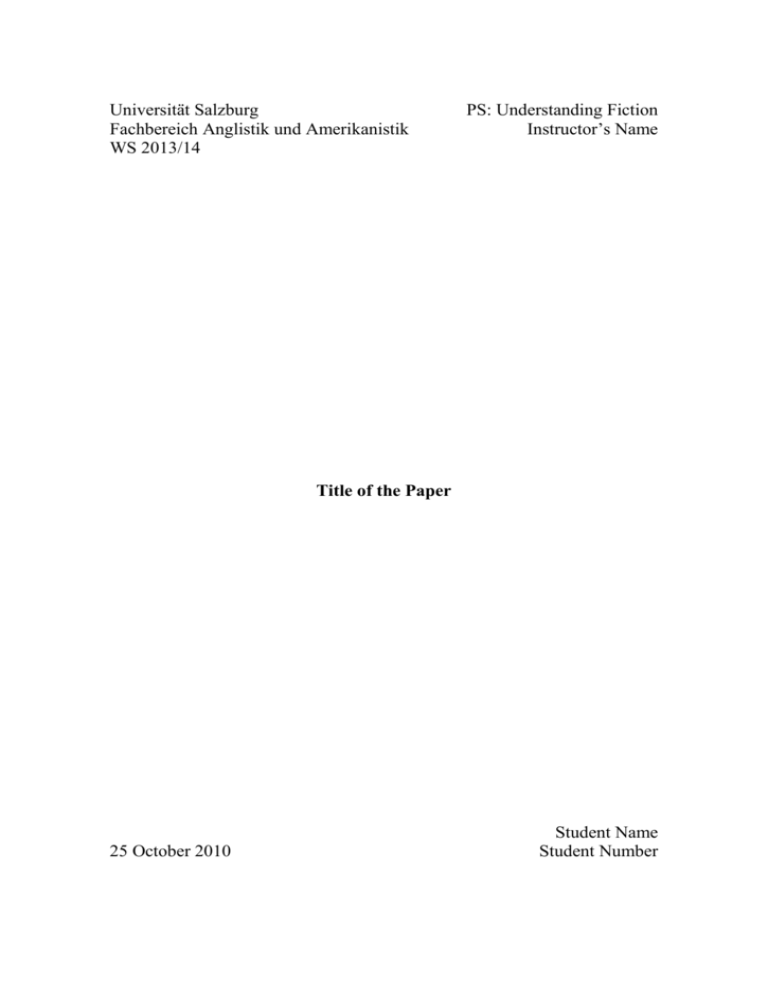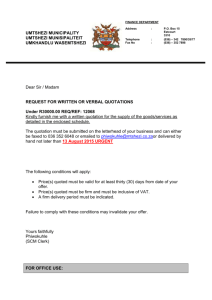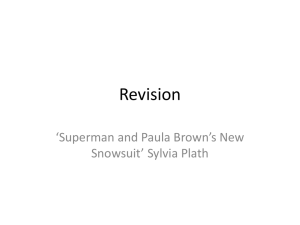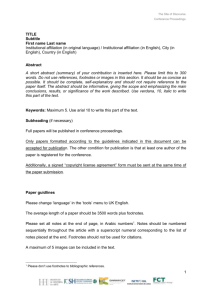Introduction - Universität Salzburg
advertisement

Universität Salzburg Fachbereich Anglistik und Amerikanistik WS 2013/14 PS: Understanding Fiction Instructor’s Name Title of the Paper 25 October 2010 Student Name Student Number CONTENTS Introduction ...................................................................................................................... 1 Paragraphs ........................................................................................................................ 1 Quotations......................................................................................................................... 2 Conclusion ........................................................................................................................ 3 Bibliography ..................................................................................................................... 4 1 Introduction This dummy paragraph is designed to show you what your paper should look on the page. The first line of a new paragraph is indented 1.25 cm, but no indentation is used at the beginning of a paper or of a new chapter or section. Use block justification and 1.5 line-spacing throughout the document so that your instructor has enough space for his or her comments. Use 12pt Times New Roman font, set the margins of your document to 3 cm on all sides, and insert page numbers centred at the top of the page. Mind also that the title of the paper and, if you want to use chapter divisions, all chapter headlines are written in Title Case, which means that all words except articles, prepositions and conjunctions are capitalized. In the introduction to your paper you ideally give a general introduction to the topic that immediately catches your reader’s interest. You should then state clearly what the topic of your paper is and present the primary text(s) you are dealing with. Furthermore, it is crucial to say what you want to show in this paper and thereby formulate a central thesis of your paper. Announce the structure of your paper in order to give your reader an overview of what he or she can expect from reading your paper. Paragraphs Guide your reader through your paper by grouping your ideas into coherent paragraphs, and by linking the paragraphs with connecting words and phrases. Notice that the first sentence of the paragraph often serves as a topic sentence, which all paragraphs need to have. With regard to the length of your paragraphs, the author of The Oxford Guide to Writing, Thomas Kane, explains that it is determined by “subject, purpose […] and individual preference” (67). But he considers a length of 120 to 150 words ideal for a well-developed paragraph. You may divide the main part of a lengthy paper into several chapters. All chapters should be logically arranged and they should have roughly the same length. This paper, therefore, does not really conform to this rule, since the first and the second chapter vary considerably in length. 2 Quotations Support your argument with quotations from the primary text and from secondary sources. It is important to always explain and discuss the quotations you give, as they do not speak for themselves. There are two main types of quotations: short quotations and long quotations. Short quotations are integrated into the running text. “This is a quotation shorter than three lines and is thus inserted in the main text.” (Chopin 44) The author’s name and the page reference are given in parenthesis right after the quotation, paraphrase, or summary. All long quotations are marked by indentation. The following quotation, for instance, shows how to format more than four lines of prose, i.e. passages taken from novels, short stories, critical texts or any other type of text written in full sentences and coherent paragraphs: This is a quotation which exceeds four lines and is therefore indented 0.5 cm at both margins. You do not need to put quotation marks here, since the block format already indicates that this is a quotation. Please use single-spaced lines. Put the name of the author and the page reference in parentheses at the end of the quotation. (Poe 186) Note that the quotation is separated from the main text by blank lines and that the line following your quotation is not indented (except if it indeed should mark a new paragraph). Secondly, when quoting more than three lines of poetry, keep the formatting as close to the original as possible and add line numbers in parenthesis. Love bade me welcome, yet my soul drew back, Guilty of dust and sin. But quick-ey’d Love, observing me grow slack From my first entrance in, Drew nearer to me, sweetly questioning If I lack’d anything. (1-6) Thirdly, if you quote dialogue from a play or film, set aside and indent the quotation and put the name of the character at the beginning of the line. Add line or page numbers for dramatic texts and time indications for films. CECILIA. Another six years of student life? ROBBIE. How else do you become a doctor? CECILIA. You could get a Fellowship now, couldn’t you? With your First. ROBBIE. But I don’t want to teach … 3 He breaks off, looks away for a moment; then turns back to her. ROBBIE. I said I’d pay your father back. CECILIA. That’s not what I meant at all. (00:21:11 - 00:22:49) Conclusion In the conclusion you sum up the main points you have made in your paper. If you go through your essay and sum up each paragraph in one or two sentences, you will not only see whether your paper follows a clear and logical structure but you will also have an almost finished conclusion at hand. Refer back to your thesis statement and make a concluding statement (but no new argument). In this section there is also room to formulate questions that might extend the initial scope of your paper and/or place your arguments in a larger context. 4 Bibliography (This is only a sample bibliography.) Atwood, Margaret. The Blind Assassin. 2000. New York: Knopf-Random, 2001. Print. Booth, Wayne C., Gregory G. Colomb, and Joseph M. Williams. The Craft of Research. 2nd ed. Chicago: University of Chicago Press, 2003. Print. Bordo, Susan. “The Moral Content of Nabokov’s Lolita.” Aesthetic Subjects. Eds. Pamela R. Matthews and David McWhirter. Minneapolis: University of Minnesota Press, 2003. 125-52. Print. Clinton, Bill. Interview by Andrew C. Revkin. “Clinton on Climate Change.” The New York Times. New York Times, May 2007. Web. 25 May 2009. Coetzee, J. M. Introduction. The Confusions of Young Törless. By Robert Musil. Trans. Shaun Whiteside. New York: Penguin, 2001. v-xiii. Print. Franklin, Benjamin. “Emigration to America.” 1782. The Faber Book of America. Eds. Christopher Ricks and William L. Vance. Boston: Faber, 1992. 24-26. Print. GlobalWarming.org. Cooler Heads Coalition, 2007. Web. 24 May 2009. Gowdy, John. “Avoiding Self-organized Extinction: Toward a Co-evolutionary Economics of Sustainability.” International Journal of Sustainable Development and World Ecology 14.1 (2007): 27-36. Print. An Inconvenient Truth. Dir. Davis Guggenheim. Perf. Al Gore, Billy West. Paramount, 2006. DVD. Jennings, Elizabeth. Frost. Writers and Critics 28. Edinburgh, London: Oliver and Boyd, 1964. Print. Leroux, Marcel. Global Warming: Myth Or Reality?: The Erring Ways of Climatology. New York: Springer, 2005. Print. Nordhaus, William D. “After Kyoto: Alternative Mechanisms to Control Global Warming.” American Economic Review 96.2 (2006): 31-34. Print. —. “Global Warming Economics.” Science 9 Nov. 2001: 1283-84. Science Online. Web. 24 May 2009. Plan, Ingo, et al. Introduction to English Linguistics. Berlin: Mouton, 2007. Print. Weisser, Susan Ostrov, ed. Women and Romance: A Reader. New York: New York UP, 2001. Print.








